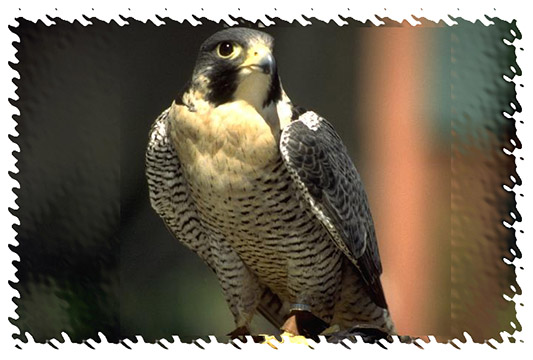

Falcons (Family Falconidae) are powerful hunters distinguished from hawks by their long wings, bent back at the wrist, narrow and pointed. Females are larger than the males.
The Peregrine Falcon (Falco peregrinus) is15-21" long and has a wingspan of 36-44". The crown and nape are black; a black wedge extends below the eye, forming a distinctive helmet, which is absent in the smaller Merlin and similar Prairie Falcon. The plumage varies from pale to very dark depending on the bird's location. Intermediate form of the west once ranged the continent. The immature Peregrine is dark brownish above, its underparts are heavily streaked. In flight the absence of contrasting axillaries and wing cover
ts distinguishes all Peregrines from Prairie Falcons. Peregrines inhabit open wetlands near cliffs; they prey chiefly on ducks, shorebirds and seabirds. Occasionally seen in cities, on bridges and tall buildings. They are rare and local in the west. Eastern breeding populations were almost exterminated in recent decades, due largely to pesticides. Peregrines have now been reintroduced in parts of their former range and are seen year-round. Most eastern sightings, however, are of migrating tundrius birds, usually along the coast in fall. They are uncommon to rare in winter in U.S.
The Peregrine is recognized as a falcon by its pointed wings, narrow tail and quick wingbeats, which are not unlike a pigeons. Its size is near that of a Crow. These and its heavy mustache indentify it. Adults are slaty-backed; pale below, with bars and spots. Young birds are dark brown above, heavily striped below.
The nest is found in a scrape on a ledge high on a cliff or building ledge or in an abandoned bird's nest. The 2-4 cream or buff eggs are spotted with reddish brown. In the Northern Hemisphere these are usually laid in mid-April. Both sexes take turns incubating for 28 to 32 days. The chicks are downy white. They leave the nest after 6 weeks, staying with their parents until the autumn, when they disperse to start life on their own.
The voice is a rasping kack-kack-kack-kack, usually heard at the nest; otherwise Peregrine's are generally silent.
Peregrine habitat is open country, especially along rivers; also near lakes, along coasts and in cities. Migrates chiefly along coasts.
Their range is from Alaska and Canadian Arctic south locally through mountainous West, and sparingly in East. Winters coastally, north to British Columbia and Massachusetts. Also in southern South America and the Old World.
Urban Peregrines subsist mainly on pigeons, which has brought it into conflict with man's interests; a problem that has existed for more than 150 years. The Peregrine climbs above its intended victim and at great speed, with wings half closed, hurtles downward in a slanting dive to strike its fatal blow. It has been suggested that its speed in this attacking dive is in excess of 100 miles per hour, but in truth it is probably around sixty-five miles per hour.
The Peregrine Falcons shown above include Houston the Douglas Peregrine Falcon, the Folkmanis Peregrine Falcon hand puppet and a Safari Peregrine Falcon figurine.
Photo of Peregrine at top from Nova Development Art Explosion.
These Peregrine Falcons are available at our sponsor's online gift shop.



